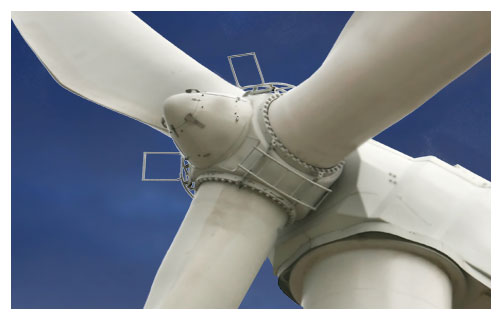



These early windmills were in many ways rather primitive devices, but the principles of their use and construction remain sound and are being applied today to help us solve the energy crisis. Wind is both free and plentiful, and with the help of modern technology, it can be captured efficiently and utilized in ways the traditional Dutch or Spanish farmer could not even have dreamed of.
A wind turbine is the modern version of the windmill; instead of generating power to mill seeds, the power is used to generate electricity. Although it may look like a huge fan, make no mistake—in a way, it's the opposite of a fan, since a fan uses electricity to produce wind, while a wind turbine uses the wind to produce electricity. They function like huge pinwheels, with blades that connect to a shaft, which spins around, producing electricity which is then sent from a substation to places where it is needed.
Wind turbines are sometimes grouped together in what are called "wind farms," which range in size from just a few turbines to many hundreds, so that larger amounts of electricity can be produced. While the majority of existing wind farms are on the land, off-shore wind farms in the ocean—like oil rigs—are a good solution to some of the obstacles of land-based wind farms, which can have problems accessing wind when there are obstacles such as buildings and trees that slow the wind down. The wind out at sea is consistent and is generally far more powerful than it is by the time it reaches the coast or areas further inland. Internationally, by the end of the next decade, the wind industry should be able—even allowing for tremendous increases in use of electricity—to supply over 10% of the world's electricity needs.
Like everything, wind turbines have some disadvantages, too. A typical turbine stands several hundred feet tall, with a diameter of perhaps half that. Some people object to their appearance, although the same could be said of every new technology that has been introduced into the landscape over the past hundred-plus years. It is for this reason that certain scenic areas, such as Cape Cod, will most probably never have a substantial wind turbine presence.
Wind turbines can also be loud, although supporters of wind energy note that the noise is only a factor when wind speeds are low, and that even this varies from one turbine to the next. The turbines, at their present stage of development, are also prone to damage by lightning, and are occasionally damaged by birds—or rather, it is the birds who are seriously damaged by the turbines.
While electric stations, coal plants, and nuclear plants are no treat to look at either, they can be more discreetly situated, and most people who live near them, as dangerous as this may be to their health and safety, are not aware of their presence in the same way that they are aware of tall, sometimes noisy, wind turbines.
Proponents of wind technology point out, however, that the pollution and general environmental damage caused by other power-generation methods are more dangerous to birds in the long run and that turbines can be erected so that they do not interfere with known migratory patterns. Double-helix turbines, also called aeroturbines, which are being developed for urban rooftop settings, have been designed to emit very little noise even in low-wind conditions. This new generation of wind turbines also has the advantage of posing no danger to birds and bats.
The advantages of a non-polluting, endlessly renewable energy source that does no permanent damage to the environment, is cheap and efficient, can empower homeowners and business owners large and small to be independent of a costly and increasingly risky power grid, can supply energy to remote areas, carry up to a quarter of the energy needs of large urban areas, and has the potential to create sustainable industries in underdeveloped areas deserves our most serious consideration.
For more information on wind energy go to:
U.S. Dept. of Energy,
"How Wind Turbines Work":
www1.eere.energy.gov
Metaefficient,
"Rooftop Turbines Ready for Commercial Use":
www.metaefficient.com
The New York Times,
"Bloomberg Eyes Danish Offshore Wind Farm and Sees New York’s Future":
www.greeninc.blogs.nytimes.com
![]()
![]()
